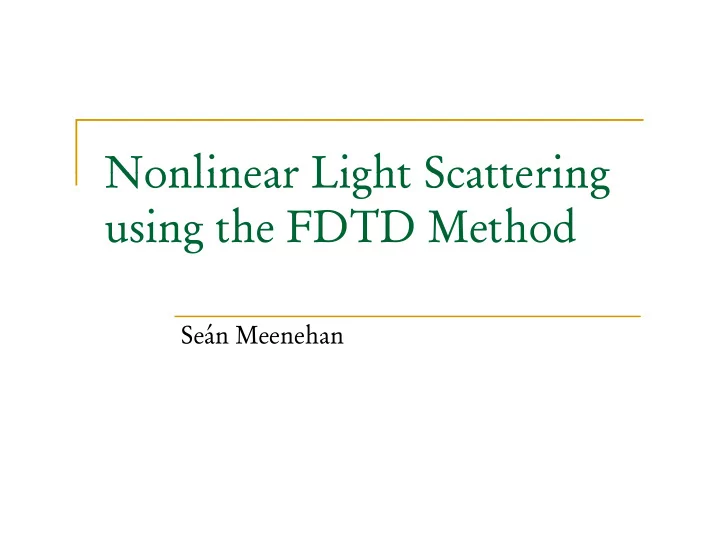

Nonlinear Light Scattering Nonlinear Light Scattering using the FDTD Method g Seán Meenehan
Second Harmonic Generation � Incident fields at frequency ω , if of sufficient intensity, Incident fields at frequency ω , if of sufficient intensity, can generate scattered fields at 2 ω . � A common example is green laser pointers � Source term for radiation is the second-order polarization, with the dominant contribution being of the form: h f ( 2 ) ( 2 ) = P P χ χ E E E E i i ijk ijk j j k k
Nonlinear Maxwell’s Equations r r r r ∇ ⋅ = + ρ ( 2 ) D P f r ∇ ∇ ⋅ = B B 0 0 r r ∂ B ∇ ∇ × = − E E ∂ t r r r r ∂ ∂ ∂ ∂ ( ( 2 2 ) ) D D P P ∇ × = + + H J ∂ ∂ t t
FDTD Method � Basic prescription: as c p esc pt o : � Discretize space and time � Express temporal and spatial derivatives in the Maxwell curl equations as finite differences i fi i diff � Split fields into scattered and incident � Rearrange equations to get scattered fields at time t = (n+1) Δ t ea a ge equat o s to get scatte ed e ds at t e t ( + ) t in terms of earlier scattered fields and incident fields. � Solve for fields in solution space for each time step, alternating between evaluating E and H and store results between evaluating E and H, and store results. � Handle boundary fields seperately at each time step
Advantages of FDTD � Easy to simulate arbitrary scattering geometries � Easy to simulate arbitrary scattering geometries (w/ staircasing error) and inhomogeneous media. � Easy to simulate any time dependent incident field with an analytical expression (e.g. laser field with an analytical expression (e.g. laser pulse which is Gaussian in time and/or spatial intensity) y) � For multiple frequency fields, we can solve for the whole field at once, instead of superposing , p p g individual frequency solutions
Assumptions � Medium is linearly isotropic (or diagonally � Medium is linearly isotropic (or diagonally anisotropic) � Medium is nonmagnetic (i e H = B) � Medium is nonmagnetic (i.e H = B) � No dispersion (dielectric response is equal for all frequencies) frequencies)
Example (linear case) ∂ ( ) ( ) r r ∂ r r r r r r ∇ × + = ε + + σ + ( H H ) E E E E inc scatt inc scatt inc scatt ∂ t ∂ ∂ ∂ ∂ H H E E y , scatt z , scatt − = ε − ε x , inc + ε x , scatt + σ + ( ) ( E E ) xx 0 xx x , inc x , scatt ∂ ∂ ∂ ∂ y y t t 1 1 1 1 + + + + n n n n − − − − H ( ( i , , j j , , k ) ) H ( ( i , , j j 1 , , k ) ) H ( ( i , , j j , , k ) ) H ( ( i , , j j , , k 1 ) ) 2 2 2 2 z , , s z , , s y y , , s y y , , s − Δ Δ y z − − ∂ n n 1 n E E E x , s x , s x , inc = ε ε + + ε ε − ε ε + + σ σ + + n n ( ( ) ) ( ( E E E E ) ) x x , inc inc x x , s s xx xx o xx Δ ∂ t t
Stability Issues � Rule of thumb for spatial discretization size is ~ λ /10 Rule of thumb for spatial discreti ation si e is λ /10 for highest frequency of interest (and no bigger than λ /4) � Need multiple samples per wavelength, also smaller grid spacing minimizes “grid dispersion” � For time spacing, use Courant condition in 3D: F i i C di i i 3D 1 Δ = t Δ + Δ + Δ 2 2 2 c x y z
Boundary Issues � In real-life, the scattered fields propagate out to � In real life, the scattered fields propagate out to infinity, but we necessarily truncate our solution space p � Need to simulate boundaries that absorb the outgoing waves to minimize reflection errors outgoing waves to minimize reflection errors � Popular scheme is the Mur boundary condition, which estimates the fields at the boundary by which estimates the fields at the boundary by interpolating past boundary fields and interior fields
Far Zone Scattering � Approximate surface integral of tangential fields � Approximate surface integral of tangential fields over the boundary at each time step � Relate these to transverse radiation fields far � Relate these to transverse radiation fields far away from the scatterer
Nonlinear Problem � The presence of the nonlinear polarization’s � The presence of the nonlinear polarization s time derivative gives us two unknowns at time step n+1 with only one equation p y q � For a single incident frequency, the time derivative just becomes i2 ω times the nonlinear derivative just becomes i2 ω times the nonlinear polarization at time step n
Recommend
More recommend